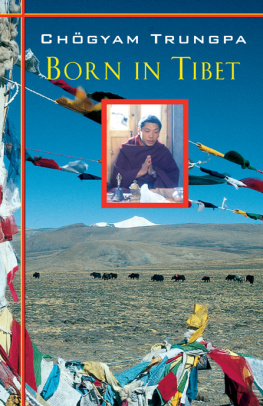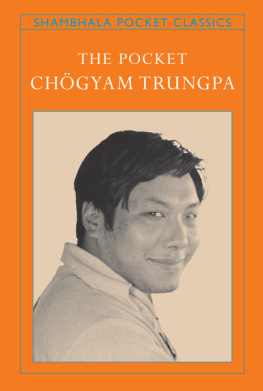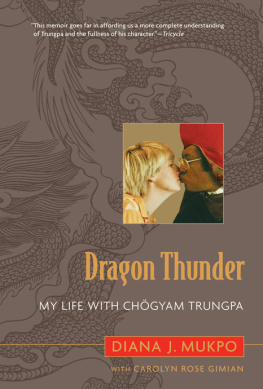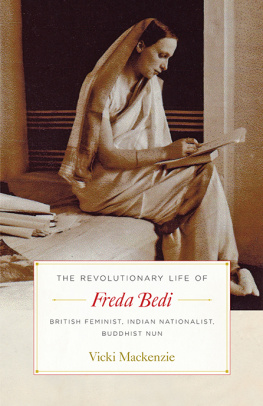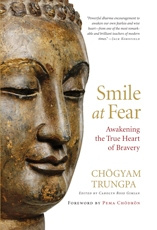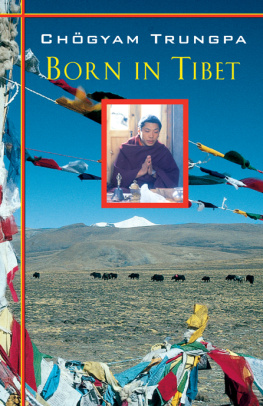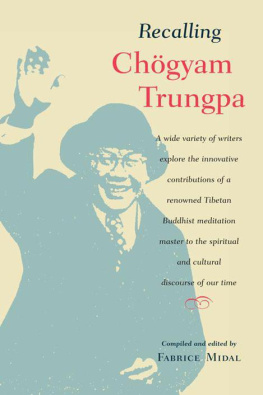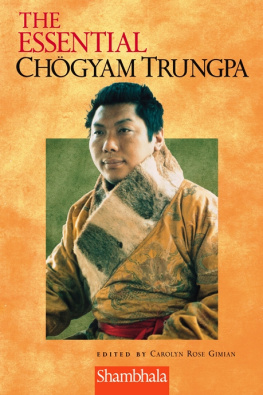DRAGON
THUNDER
My Life with Chgyam Trungpa
Diana J. Mukpo
with Carolyn Rose Gimian

Shambhala
Boston & London
2010
S HAMBHALA P UBLICATIONS , I NC .
Horticultural Hall
300 Massachusetts Avenue
Boston, Massachusetts 02115
www.shambhala.com
2006 by Diana J. Mukpo and Carolyn R. Gimian
All rights reserved. No part of this book may be reproduced in any form or by any means, electronic or mechanical, including photocopying, recording, or by any information storage and retrieval system, without permission in writing from the publisher.
Library of Congress Cataloging-in-Publication Data
Mukpo, Diana J.
Dragon thunder: my life with Chgyam Trungpa/Diana J. Mukpo; with
Carolyn Rose Gimian.1st ed.
p. cm.
eISBN 978-0-8348-2161-3
ISBN 978-1-59030-256-9
ISBN 1-59030-256-7
1. Trungpa, Chgyam, 19391987. 2. LamasBiography. 3. Mukpo, Diana J.
I. Gimian, Carolyn Rose. II. Title.
BQ990.R867M86 2006
2943923092dc22
[B]
2006013421
To my family
Bringing together sun and moon,
Dragon thunder proclaims
Let us rejoice in the name of the Great Eastern Sun.
C HGYAM T RUNGPA, FROM THE UNPUBLISHED MANUSCRIPT T HE M EMOIRS OF S IR N YIMA S ANGPO , W.O.D.S.
CONTENTS
ABOUT CHGYAM TRUNGPA AND DIANA MUKPO
C hgyam Trungpa (19401987) is widely considered one of the most important and influential Buddhist teachers of our time. Born in Tibet, he was forced to flee to India in 1959, during the Chinese invasion of his country. In 1963, he traveled to England to study at Oxford University. While in England, he published Meditation in Action (1969), a classic of twentieth-century spiritual literature that has introduced hundreds of thousands of Westerners to Buddhism. Chgyam Trungpa moved to the United States in 1970 and went on to publish more than a dozen books on Buddhism and the spiritual path, including two widely popular and highly influential works, Cutting Through Spiritual Materialism (1973) and Shambhala: Sacred Path of the Warrior (1984).
In 1970, while still in Britain, Chgyam Trungpa married a young English woman named Diana Pybus. In Dragon Thunder Diana shares the intriguing and poignant story of their life together. Over the course of their seventeen-year marriage, Chgyam Trungpa established meditation centers around the United States, Canada, and Europe. He also founded Naropa, the first Buddhist-inspired university in North America. In addition, he attracted students from around the world and became friend and mentor to some of the leading artists of the day, including the poet Allen Ginsberg. A bride at age sixteen, Dianas narrative is an unusual coming-of-age story, as well as a rare glimpse into the personal life of one of the most enigmatic Buddhist teachers to come to the West.
O NE
T his is the story of my life, and it is also an intimate portrait of my husband, Chgyam Trungpa Rinpoche. The two things are quite intertwined for me. My husband was a Tibetan Buddhist lama, the eleventh incarnation in the Trungpa lineage and the abbot of Surmang, a major group of monasteries in Eastern Tibet. Rinpoche (pronounced RIM-poach-eh), the name by which I usually called him, is a title for great lamas and incarnate teachers, which means precious one. Rinpoche left Tibet in 1959 because of the communist Chinese invasion of his country, and after spending a few years in India, he came to England. I met him there when he was twenty-eight and I was fifteen. We were married when I was sixteen, which was quite shocking to both my family and to Rinpoches Tibetan colleagues. We loved each other deeply, and we had a very special connection. However, our marriage was highly unconventional by most standards, and it was not without heartbreak or difficulty. In the end I have no regrets.
Rinpoche was one of the first Tibetan Buddhist teachers in the West and one of the very first to teach Westerners in the English language. The time that he spent in the Westbetween 1963, when he arrived in England, and 1987, when he died in North Americawas an important period for the transplantation of Buddhism to the West, and I hope that my viewpoint as his wife may offer a unique perspective on that period. A lot of what my life was about during those years was about him and what happened to him. So a main objective for telling my story is so that the memory of him and of all those things that happened can be preserved.
I also want to talk about our life together and our relationship because it was so human and so intimate. Ultimately I think that this is the essence of the Buddhist teachings: they are about how to live our lives as human beings, intimately, moment by moment. So I will try to share with you what it was really like to love such a person. It was quite extraordinary.
The first time I saw Rinpoche was in December of 1968, during my Christmas break from Benenden School, an elite English boarding school for girls. I was fifteen at the time, and I was spending the holidays at home with my mother and my sister in London. The previous summer, my sister Tessa and I had traveled with Mother to Malta. At that point in my life, I couldnt communicate at all with my mother, and I felt claustrophobic around her. While we were in Malta, I withdrew more and more into myself, and I read many books about Theravada, Zen, and Tibetan Buddhism. When we got back to London, I started to go to lectures and other events at the Buddhist Society in Eccleston Square. Buddhism was not particularly popular at that time, and none of my friends were interested in it. However, my father had had an interest in Buddhism and after his death, when I was thirteen, I began to question and explore my own spirituality, first reading about comparative religion and then focusing on Buddhist writings. In the autumn of 1968, I read Born in Tibet, Rinpoches book about his upbringing in Tibet and his escape from the Chinese. I thought it was an exciting and somewhat exotic story. However, the book was nowhere near as thrilling as meeting the author proved to be!
Over the Christmas holidays, I went to St. Georges Hall to attend a rally for the liberation of Tibet, sponsored by the Buddhist Society. The program went on for several hours, with one speaker after another. I found it quite boring. One of the last speakers on the schedule was the author of Born in Tibet, Chgyam Trungpa Rinpoche, who appeared onstage in the maroon and saffron robes of a Tibetan monk. I looked up at him from the audience, and much to my amazement, I felt an immediate and intense connection. Before he could say anything, however, he collapsed and was carried offstage. We were told that Rinpoche had taken ill, but I imagine that alcohol may have been involved.
Although he was only onstage for a few minutes, I knew that I had a very deep and old connection with him, and it stirred up a great deal of emotion for me. The only way I can describe this experience is that it was like coming home. Nothing in my life had hit me in such a powerful way. I said to myself, This is what Ive been missing all my life. Here he is again. This wasnt just some exciting, powerful experience. I knew him, and as soon as I saw him, I realized how much Id been missing him. From that moment on, I wanted desperately to meet him.
Since the age of thirteen, shortly after my fathers death, I had had several very vivid dreams about previous lives in Tibet. I didnt tell anyone about them because I didnt know what to say about them, and I thought that people might misunderstand. I didnt really understand these dreams myself, although somehow I knew that the location was Tibet and these were about previous lives. When I saw Rinpoche, I knew that he was connected to the world that I had encountered in my dreams.
Next page




